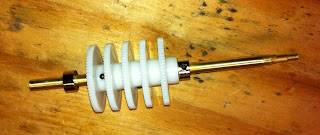Before I embarked on the build of the project I was torn between using servo motors or using stepper motors. I had originally opted for the servos because an Arduino can only control 2 steppers with the motor shield, and up to 3 with the EasyDriver Stepper controller. I need 5 motors, so each of these options was out and I went with servos instead. After some frustration with the servos, I started to reconsider how I might control more steppers with the Arduino. I remembered back to my college days of basic circuit design and remembered a device called a demuxer that could control multiple output lines with fewer input lines triggered by a binary pattern. I checked out the EasyDriver again, and it has an "enable" pin that "enables" the board and the motor. If I could take 3 digital lines from the Arduino through a demux I should be able to control up to 8 stepper motors (each with their own EasyDriver). I took down some notes (which I will add later) to detai
